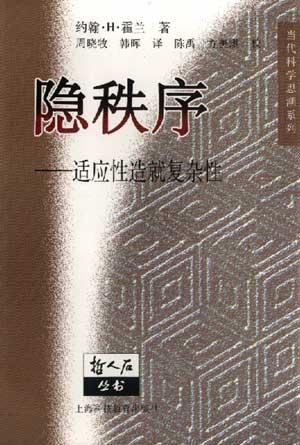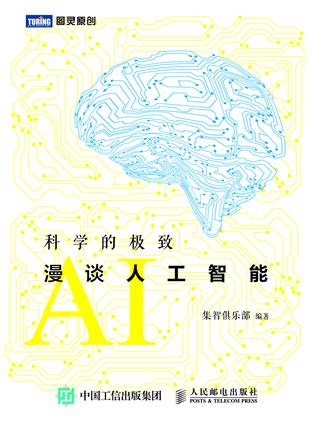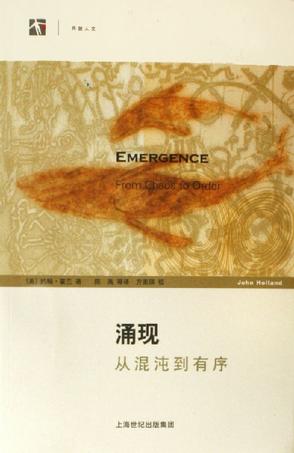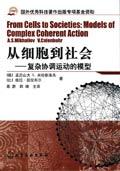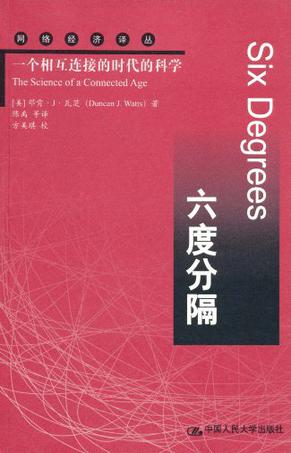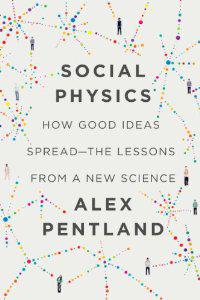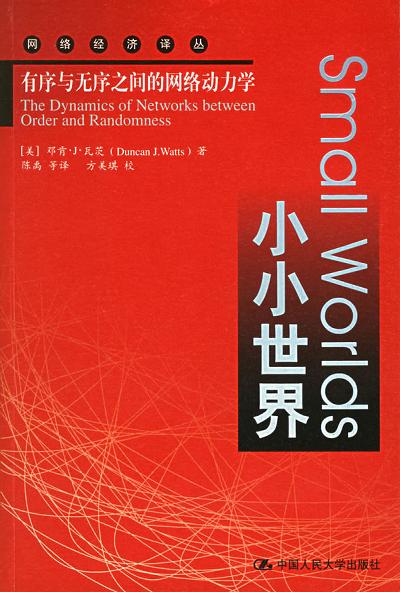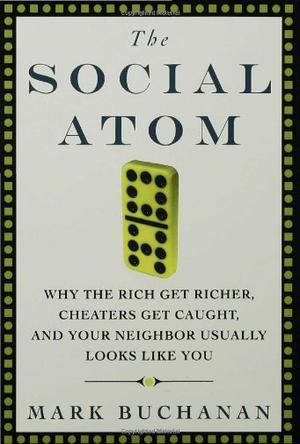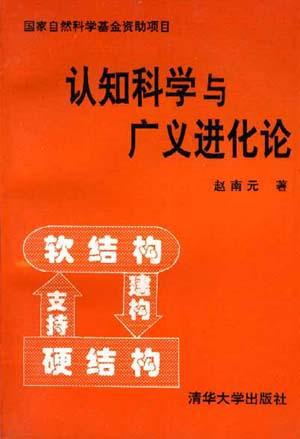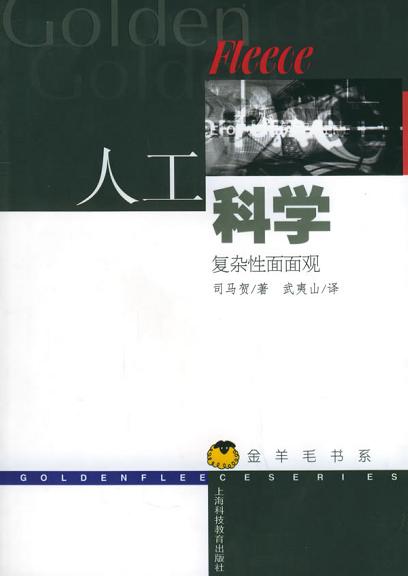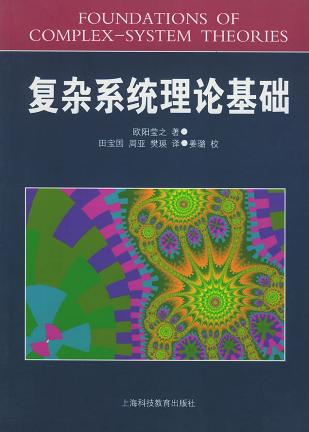欢迎来到相识电子书!
标签:复杂系统
-
隐秩序
像艾滋病一类疾病为何能够摧毁免疫系统?像纽约、东京这样的大城市如何能够不间断地保障食品、医疗、服饰和数百万种居民必需品的供给?这类高度复杂系统的运作仍然是一个谜。但是通过霍兰及其同事在圣菲研究所和密歇根大学的工作,现在已经接近找到一种解答。 作为遗传算法之父和复杂性新科学的先驱者之一,霍兰从一开始就处于复杂适应系统(CAS)这一新兴研究领域的中心。 这部里程碑式著作为这一崭新领域首次提供了一种协调一致的综合,展示了霍兰的独特洞见。本书强调寻找支配CAS行为的一般原理,注重扩展众多科学家的直觉。书中提供了一个适用于全部CAS的计算机模型。霍兰通过描述我们能够做什么,总结了如何增强对CAS的理论认识。他提出的若干理论方法,可以指导人们对付耗尽资源、置我们世界于危险境地的棘手CAS问题。 -
科学的极致:漫谈人工智能
集智俱乐部是一个从事学术研究、享受科学乐趣的探索者组成的团体,倡导以平等开放的态度、科学实证的精神进行跨学科的研究与交流,力图搭建一个中国的“没有围墙的研究所”。这些令人崇敬的、充满激情与梦想的集智俱乐部成员将带你了解图灵机模型、冯•诺依曼计算机体系结构、怪圈与哥德尔定理、通用人工智能、深度学习、人类计算与自然语言处理,与你一起展开一场令人热血沸腾的科学之旅。 -
涌现
本书作者是当今最具有创新意识的思想家之一,本书也是对涌现现象进行深入探索的第一部著作。在本书中,作者比较了显示涌现现象的不同系统和模型,展现了它们之间共同的规则或规律,讲述了从“蕴含着规范、能够生成像巨大的红杉和普通的雏菊那样复杂而独特结构”的微小种子,到能够通过自学习在西洋跳棋游戏中让设计者一败涂地的计算机;从能够修建桥梁、跨越深沟和驾驭树叶之舟在溪流上航行的蚁群,到诗人充满感情的创作等涌现现象的具体表现。 涌现的概念(即整体大于其各部分之和)简单得令人惊讶,然而它在科学、商业以及艺术等诸多领域牛都具有极深的寓意。本书中,作者用深入浅出的描述向我们生动地阐明:涌现的理论能够预言许多复杂的行为,同时也给予我们关于生命、智慧和组织的很多启示。 序言 第一章 启程之前 走向何方 模型 研究道路上的困难 取得的进展 第二章 游戏与数字 西洋跳棋和神经网络 模型中的秘密 棋类游戏及规则 数字 积木块 计算机模型 第三章 地图、对策论和计算机建模 博弈和对策论 涌现——初露端倪 动态模型 计算机模型——进一步的研究, 第四章 西洋跳棋 困难何在 塞缪尔是如何做的 对走法的估价 由估价到策略 学习的过程 使学习过程运转起来 需要注意的问题 权重改变引起的涌现结果 小结 第五章 神经网络 神经元的特征 为神经元建模 固定阈值的神经元网络 区别与局限 有关神经元的更多特征 带环路的网络 无限期的记忆 三角形的识别——一个例子 综合 对比 继续前进 第六章 普适理论 基于主体的模型 计算机的参与 涌现和非线性 普适理论的基本要求 第七章 受限生成过程 机制 相互作用和连接 元胞自动机 第八章 西洋跳棋程序和其他受限生成过程模型 塞缪尔的西洋跳棋程序 中枢神经系统模型 复制猫 第九章 变易 具有可变结构的受限生成过程模型 示例 遗传算法和可变结构的受限生成过程模型 关于涌现的进一步理解 第十章 层次描述和还原方法 层次 如何组装元胞自动机 第十一章 隐喻和创新 科学中的创新和创造 对隐喻的初步探讨 隐喻和模型的关系 创新的培育 小结 诗歌和物理学 第十二章 结束语 作为总结的“结束语” 作为继续研究起点的“结束语” 综合 关于涌现的进一步研究 涌现的目标 涌现研究的远期目标 -
还原论的局限
《还原论的局限:来自活细胞的训诫》简介:罗思曼博士指出,将生命的物质体现或是生命的组成部分的加合等同于生命整体本身,是与对自组细胞的实验观察相悖的一种错误的信念。这种信念,来源于至今仍统治着生物学界研究思维方式的“强微观还原论”。 经过40年来同这种还原论方法的斗争,罗思曼博士用自己的故事,向我们讲述了关于科学争议机制以及科学本质的令人耳目一新的一面。 -
从细胞到社会
本书是复杂性科学方面一本引人入胜的介绍性读物。作者由简到繁地介绍目前复杂性研究中遇到的各种典型系统,从无分化的相干运动集群到上具有内部动力学的单元模型,从相不干动作组的自发形成,到基层组织的出现等,直至动态网络的涌现和演化。通过对这些系统中反应——扩散耦合、主动运动、互相同步和聚类形成等现象的形成机理分析,深入浅出地阐述了复杂系统的重要共性和本质问题。 本书覆盖面较广,但自成体系,对理工科类的大学高年级学生和研究生及相关领域的广大科技工作者都具有重要的参考价值。 -
六度分隔
正如副标题所表明的,《六度分隔:一个相互连接的时代的科学》的基本内容是介绍一门正在形成中的新科学——关于网络的一般规律的科学。有这样一门科学吗?它的内容和方法是什么?近年来,这门学科有什么实质性的进展吗?在《六度分隔:一个相互连接的时代的科学》中,作者根据自己的亲身经历娓娓道来,用讲故事的方式,对于这些问题给出了令人信服的回答 除了简要的背景和总结以外,《六度分隔:一个相互连接的时代的科学》可以分成两大部分前半部分讲述了学科产生的背景和主要的理论模型其中特别值得注意的是,第3章介绍的是小世界网络模型,第4章介绍无标度网络模型,第五章则介绍了关于搜索的模型这三章的介绍包括了这些模型的内容和意义这三章具有较强的理论性后半部分则广泛地介绍了在若干应用领域的应用状况。第6章讨论了疾病和计算机病毒的传播中的问题第7、8章研究了另外一些社会现象,例如,文化时尚、政治动乱,金融泡沫等告诉了我们什么。第9章则讨论了组织的坚固性和它对现代公司企业的启示。最后第10章对全书进行总结,提出一个简要的概括 对于具有高中以上文化基础的社会大众来说,可以通过阅读《六度分隔:一个相互连接的时代的科学》概括性地了解关于网络新科学的概况与最新进展而对于有兴趣深入了解现代系统科学,以及正在形成中的一般网络科学的读者,《六度分隔:一个相互连接的时代的科学》则是一个很好的入口和索引。 -
Social Physics: How Good Ideas Spread
From one of the world’s leading data scientists, a landmark tour ofthe new science of idea flow, offering revolutionary insights into the mysteries of collective intelligence and social influence If the Big Data revolution has a presiding genius, it is MIT’s Alex “Sandy” Pentland. Over years of groundbreaking experiments, he has distilled remarkable discoveries significant enough to become the bedrock of a whole new scientific field: social physics. Humans have more in common with bees than we like to admit: We’re social creatures first and foremost. Our most important habits of action—and most basic notions of common sense—are wired into us through our coordination in social groups. Social physics is about idea flow, the way human social networks spread ideas and transform those ideas into behaviors. Thanks to the millions of digital bread crumbs people leave behind via smartphones, GPS devices, and the Internet, the amount of new information we have about human activity is truly profound. Until now, sociologists have depended on limited data sets and surveys that tell us how people say they think and behave, rather than what they actually do. As a result, we’ve been stuck with the same stale social structures—classes, markets—and a focus on individual actors, data snapshots, and steady states. Pentland shows that, in fact, humans respond much more powerfully to social incentives that involve rewarding others and strengthening the ties that bind than incentives that involve only their own economic self-interest. Pentland and his teams have found that they can study patterns of information exchange in a social network without any knowledge of the actual content of the information and predict with stunning accuracy how productive and effective that network is, whether it’s a business or an entire city. We can maximize a group’s collective intelligence to improve performance and use social incentives to create new organizations and guide them through disruptive change in a way that maximizes the good. At every level of interaction, from small groups to large cities, social networks can be tuned to increase exploration and engagement, thus vastly improving idea flow. Social Physics will change the way we think about how we learn and how our social groups work—and can be made to work better, at every level of society. Pentland leads readers to the edge of the most important revolution in the study of social behavior in a generation, an entirely new way to look at life itself. -
小小世界
《小小世界》内容简介:每个人都熟悉所谓“小世界现象”:当你遇见一个陌生人交谈不久之后,往往会惊奇地发现:“原来我们有共同的朋友!”或者说,仅通过几个熟识的人,我们就早已经相互联系在一起了,在这《小小世界》(有序与无序之间的网络动力学)中,邓肯·瓦茨(Duncan watts)将这种有趣的现象——俗称“六度分离” (six degrees of separation)——作为研究更一般现象的引子即证明了:在某种特定的条件下,小世界现象会出现在任何一种类型的网络之中。能够作为这一研究素材的网络无所不在:大脑是一个神经网络;社会上的组织是人际网络;全球的经济是国民经济组成的网络,国民经济又是市场组成的网络,而市场则是相互作用的生产者和消费者组成的网络。食物链、生态系统以及因特网也都表现出网络特征。此外,解决某一问题的策略,一次谈话中的主题,甚至一种语言中的词汇都能够形成某种意义上的网络。作者断言,这些网络都将归为“小世界网络”。这类网络是如何作用的呢?简单地说,是局部行为导致了全局性的结果,而局部动态特性和全局动态特性之间的关系,则主要依赖于网络的结构,瓦茨利用多种简单的模型阐明了这一关系的微妙之处,这些模型包括:人群中传染病的传播;博弈论中合作的演化;元胞自动机(即Cellutar Automata,CA)的计算能力以及耦合相位振子的同步等等。 -
The Social Atom
The idiosyncrasies of human decision-making have confounded economists and social theorists for years. If each person makes choices for personal (and often irrational) reasons, how can people's choices be predicted by a single theory? How can "any" economic, social, or political theory be valid? The truth is, none of them really are. Mark Buchanan makes the fascinating argument that the science of physics is beginning to provide a new picture of the human or "social atom," and help us understand the surprising, and often predictable, patterns that emerge when they get together. Look at patterns, not people, Buchanan argues, and rules emerge that can explain how movements form, how interest groups operate, and even why ethnic hatred persists. Using similar observations, social physicists can predict whether neighborhoods will integrate, whether stock markets will crash, and whether crime waves will continue or abate. Brimming with mind games and provocative experiments, "The Social Atom" is an incisive, accessible, and comprehensive argument for a whole new way to look at human social behavior. Mark Buchanan is a theoretical physicist and an associate editor at "Complexus," a journal on biocomplexity. He has been an editor at "Nature" and "New Scientist," and is the author of two prize-nominated books, "Ubiquity: The Science of History" and "Nexus: Small Worlds and the Groundbreaking Science of Networks." He lives in Cambridgeshire, England. The idiosyncrasies of human decision-making have confounded economists and social theorists for years. If each person makes choices for personal (and often irrational) reasons, how can people's choices be predicted by a single theory? The validity of any economic, social, or political theory comes into question. Mark Buchanan argues that the science of physics is beginning to provide a new picture of the human or "social atom," and help us understand the surprising, and often predictable, patterns that emerge when they get together. Look at patterns, not people, Buchanan argues, and rules emerge that can explain how movements form, how interest groups operate, and even why ethnic hatred persists. Using similar observations, social physicists can predict whether neighborhoods will integrate, whether stock markets will crash, and whether crime waves will continue or abate. "The Social Atom" is an incisive, accessible, and comprehensive argument for a new way to look at human social behavior. "Mark Buchanan is] a theoretical physicist . . . Buchanan argues that one of the basic assumptions of economics--namely, that humans make only reasoned, greedy, self-promoting decisions--is a simplification that calls the whole field into question . . . A former editor of the prestigious science journal "Nature," Buchanan witnessed a growing number of physicists write papers about familiar mathematical patterns cropping up in human behavior. This inspired him to write "The Social Atom." His goal is to consider people 'as if they were atoms or molecules following fairly simple rules' and investigate the idea that 'seemingly complicated social happenings may often have quite simple origins, and that we can discover such simplicity by examining how we too may be subject to laws not unlike those of physics' . . . The book asks] readers to move away from thinking of humans as individuals when it comes to social behavior in a group. We are . . . simple atoms that think alike, copy one another and self-organize according to common mathematical patterns."--Russ Juskalian, "USA Today" "Humans mimic other humans, whether they're clapping or buying mobile phones, writes Mark Buchanan in his beguiling behavioral study . . . Yet the same force may influence bigger decisions in life, like whether to have kids, he says. European birthrates slowed so dramatically between 1950 and 2000 that researchers concluded the trend was 'amplified and exaggerated by peer pressure' . . . A theoretical physicist, Buchanan suggests that sociologists should spend less time scrutinizing individual behavior and more time studying the group. 'Think of patterns, not people, ' he urges, arguing that people are the atoms, or building blocks, of the social world. We imitate each other, cooperate, learn and adapt in a giant feedback system. Writing in lean, fluid sentences, Buchanan clicks through examples ranging from the collapse of Long-Term Capital Management to the slaughter at Srebrenica. He shows patterns at work in phantom traffic jams, stock sell-offs and the trails human feet carve through public parks . . . As promised in the book's subtitle, Buchanan explains 'Why the Rich Get Richer, Cheaters Get Caught, and Your Neighbor Usually Looks Like You' . . . Buchanan is] on to something big."--James Pressley, "Bloomberg News" "Likely the "Blink" or "Freakonomics "of 2007, theoretical physicist Buchanan's new book explains how we replicate the behavior of people we admire, and stick close to people with shared fundamental bonds such as ethnic heritage.""--Time Out Chicago" "Everything we think about why we do what we do is wrong because we can't help but think and act like individuals, understanding the world around us with anecdote and simple stories. But as Mark Buchanan brilliantly demonstrates with examples from the world all around us, there's a bigger force at work that explains the world far better. Surprisingly, that force looks a lot like the semi-random statistical model that explained the mysteries of quantum physics a century ago. This is a fascinating glimpse into a new way of understanding human behavior."--Chris Anderson, Editor-in-Chief, "Wired Magazine," and author of "The Long Tail: Why The Future of Business Is Selling Less of More""" "Seldom has a book so infuriated me yet kept me tightly gripped to each page. This is a first-class attack on the smugness of the Humanities by a brilliant provocateur: a disturbing challenge to all of us who think we understan -
Expert Political Judgment
It is the somewhat gratifying lesson of Philip Tetlock's new book . . . that people who make prediction their business--people who appear as experts on television, get quoted in newspaper articles, advise governments and businesses, and participate in punditry roundtables--are no better than the rest of us. When they're wrong, they're rarely held accountable, and they rarely admit it, either. . . . It would be nice if there were fewer partisans on television disguised as "analysts" and "experts". . . . But the best lesson of Tetlock's book may be the one that he seems most reluctant to draw: Think for yourself. -
认知科学与广义进化论
内容简介:《认知科学与广义进化论》一书是著者所承担的国家自然科学基金项目的研究成果。在本书中著者创立了横跨哲学认识论、比较文化学、进化生物学、计算机科学、系统科学等多学科的高度统一的认知科学基础理论――广义进化论。并探讨了该理论在建立伦理学、美学等社会科学基础方面的作用。本书论点丰富新颖,论证严密科学,表达深入浅出,不仅适合于有关学科的教学、科研人员参考,而且适合于一般读者阅读。 -
人工科学
本书是诺贝尔经济学奖得主司马贺的代表作之一,是1996年修订出版的第三版的中译本。第三版增加了全新的一章“复杂性面面观”,修改了文字内容并更新了部分数据。 作者率先构造出“人工科学”的概念,据以将经济学、思维心理学、学习科学、设计科学、管理学、复杂性研究等领域贯穿联系起来,使人获得很多启迪。本书对传统思维提出挑战,指出人工智能所期望达到的领域,揭示了人工性和层级对于复杂性的意义,从多个领域说明人工科学何以是可能的,并试图说明它的性质。本书的基本主题是:物质符号系统具备必要和充分的手段来采取智能行动。 -
恢复力
在这个越来越复杂的世界中,我们人类是没有办法避免各种冲击的——我们能够做的,就是对冲击进行更好的缓冲。本书对如何进行缓冲进行了卓越的探索,提供了许多例证和故事,极具说服力。 ——克里斯•安德森 《连线》杂志前主编,畅销书《长尾理论》、《免费》、《创客》作者 从生态系统到社区,再到商界,本书告诉我们,做一个强者并不是说把某一件事情做好。相反,做一个强者,就是做事情有弹性,有余地,绝不一成不变。作者完成了一本非常重要也非常有益的好书,它帮助读者去理解对未来进行计划是一件非常重要的事情,哪怕放弃一些短期利益也在所不惜。 ——丹•艾瑞里 杜克大学教授、《怪诞行为学》作者 《恢复力》是一本非常棒的书。在紧密联结、错综复杂并且自发组织的系统当中,恢复力是健康、福祉和机遇的关键因素。作者为我们走向一个更加具有恢复力的世界提供了路线图。 ——安妮—玛丽•斯劳特 普林斯顿大学政治与国际事务教授 本书充满智慧,富有深度,是该领域里程碑式的一部力作。如果你身处于某个系统之中,想要避免系统的崩溃,就一定要阅读这本书。 ——戴维•伊葛门 神经学家,著有《隐姓埋名》和《网络为什么重要》 《恢复力》一书适合任何人阅读,它将改变你对于全球每天所发生的事件的看法。这本书既涉及复杂理论,又涉及心理学,对于理解当下不可或缺,对于规划未来举足轻重。 ——戴维•奥格斯 南加州大学医学工程教授,著有《疾病的终结》一书 在这本书中,作者综合了世界顶尖的科学研究、前沿的社会创新和生态创新,以一种全新的思路阐述了如何重建一个更具恢复力的新世界。向读者介绍了在系统受到影响时如何恢复状态,如何在崩溃状况下进行结构重组;如何提高自身心理承受能力,如何提高企业凝聚力以及恢复力强大的组织要具备什么样的领导力。 作者提到,我们对于崩溃本身能做的非常有限,但是我们完全可以学会如何去应对崩溃。作者通过全世界各地创新者的故事、他自身的实践经验以及富有深度的原创性研究,展示了恢复力是如何影响我们当今世界的。同时,他还着眼于变幻莫测的未来,探讨了恢复力将如何帮助我们迅速恢复活力与最佳状态。 作者站在了恢复力研究的最前沿,向读者展示了个人、社群、企业、组织、经济体甚至整个世界如何适应变幻莫测的各种环境。不论你是一位科学家、经济学家、社会创新者,还是公司领导人、公众领袖,抑或是普通民众,这本书既能发人深省,又能开阔思维。 -
复杂社会的崩溃
目录 鸣谢/1 第一章有关崩溃的导言/1 什么是崩溃?/7 历史上的崩溃现象/9 西周帝国/9 哈拉巴文明/10 美索不达米亚/11 埃及古王国/13 赫梯帝国/14 克里特文明/16 迈锡尼文明/17 西罗马帝国/19 奥尔梅克/20 玛雅低地古典文明/21 中美洲高地文明/22 大卡萨斯/24 查科文明/25 霍霍坎文明/26 东部林地文化/27 瓦里帝国和蒂亚瓦纳科帝国/28 克钦族/29 伊克族/30 说明/31 崩溃之后/31 第二章复杂社会的性质/35 引言/37 复杂化/38 复杂化的本质/38 简单社会/39 国家/42 复杂化层次/45 复杂化进程/49 总结和寓意/56 第三章有关崩溃的研究/59 引言/61 进一步定义崩溃/62 理论分类/65 研究框架/66 资源枯竭/67 古中美洲/70 秘鲁/70 美国西南部/71 北美洲东部/71 埃及/72 印度河文明/73 美索不达米亚/73 迈锡尼文明/74 罗马帝国/74 简评/75 新资源/77 简评/78 自然灾害/78 古中美洲/79 弥诺斯文明/79 罗马帝国/79 简评/80 面临环境变化的对策不足/81 简评/87 其他复杂社会/90 简评/90 外来入侵/91 北美和南美/91 哈拉巴文明/93 美索不达米亚/93 赫梯帝国/93 弥诺斯文明/93 迈锡尼文明/94 罗马帝国/94 中国/94 简评/94 冲突、矛盾和管理不当/95 普遍案例/96 古中美洲/98 秘鲁/99 中国/99 关索不达米亚/100 罗马帝国/101 拜占庭帝国/103 西班牙/103 荷兰/104 哈拉巴/104 复活节岛/104 简评/104 社会功能紊乱/107 简评/107 神秘因素/108 简评/120 事件的连锁与巧合/125 简评/125 经济学阐释/125 简评/127 总结和探讨/128 第四章理解崩溃:社会政治变化中的边际产量/131 复杂化增长状态下的边际产量/136 农业和资源生产/137 信息处理/143 社会政治控制和阶层特殊化/151 整体经济产能/153 理解复杂社会边际收益递减现象/155 农业和资源生产/156 信息处理/157 社会政治控制和阶层特殊化/162 整体经济产能/165 阐释崩溃/166 面临崩溃的其他选择/172 第五章整体评估:社会复杂化和崩溃社会的边际回报/177 西罗马帝国的崩溃/181 罗马崩溃评估/207 古典玛雅的崩溃/212 背景/212 观察玛雅/215 玛雅文明的进化/217 人口增长/220 生存状态/221 社会政治复杂化/223 战事冲突/227 玛雅崩溃/229 玛雅崩溃评估/232 查科的崩溃/241 查科崩溃评估/248 评估/254 罗马的崩溃/254 玛雅的崩溃/255 查科的崩溃/257 结论/258 第六章总结和寓意/261 总结/263 崩溃与复杂社会的产量下降/268 边际回报下降的更多含义/271 关于继续运用该理论的几点建议/276 边际收益递减与其他崩溃理论/279 当代社会的发展状况/284 出版后记进步主义的终结?/293 -
无尽之形最美
生命最伟大的奇观体现在单个细胞(受精卵)发育成数十亿乃至数万亿个细胞而组建动物的过程。长久以来,科学家们就知道,要是能够阐明胚胎中形态和模式图案如何出现的话,他们就能够清楚地理解今天令人惊叹的动物界的多样性是怎样从5亿年前的原始形态演化而来的。在《无尽之形最美(动物建造和演化的奥秘)》中,著名生物学家肖恩·卡罗尔,演化发育生物学开创者之一,为广大读者打开了令人振奋的崭新生物学分支一一演化发育生物学的黑匣子,展示了这场令人叹为观止的科学革命。书中详细叙述了各种各样的动物,包括我们人类本身是如何建造的以及它们的分子遗传基础。《无尽之形最美(动物建造和演化的奥秘)》的英文版出版后获得一致好评,荣获多项奖励,如美国《发现》杂志和《今日美国》报等的科技图书年度奖。 -
探索复杂性
《探索复杂性》内容简介:耗散结构理论由于在社会经济等大范围领域中展现的广阔前景,引起了人们的极大兴趣,与协同论、突变论并称为现代科学方法论的新三论。美国著名作家托夫勒认为,这一理论“可能代表了下一次科学革命”。《探索复杂性》作者之一普利高津因提出这一理论而获得1977年诺贝尔奖,《探索复杂性》的另一作者布鲁塞尔学派主要成员尼科里斯教授,是欧洲著名的物理学家,对发展耗散结构理论做出了杰出的贡献。 书中全面地介绍了以耗散结构理论为代表的进化论物理学的最新成就,着力于打破自然科学各门类之间乃至自然科学与社会科学之间的壁垒,再次点燃科学革命之火。 《探索复杂性》内容新颖、文笔优美、深入浅出,适宜于物理学、化学、数学、生物学、医学、地质学等专业的科学工作者、大专院校师生阅读,也适宜于社会科学工作者和具有中等文化程度的读者阅读。 -
复杂系统理论基础
本书的相当大部分致力于对科学理论和模型的表述,从而为进行哲学分析提供素材。由于多体系统的复杂性,诸学科基本上依赖于理想化和近似,各学科部分成了许多强调系统不同假面的模型。我将尽力展开模型。背扣的假设和预设,便于读者评价它们那些通常是有文化影响的声称。除了对一般概念进行澄清,我希望本书可以激起不同领域科学家之间的相互对话,不仅关于他们正在研究什么,还关于他们正在如何进行。因此,我努力使本书的内容易于一般读者理解,把诸学科的概念结构(conceptual struc-tures)尽可能解释清楚,尽量少引用行话,并在每一专业术语第一次出现时予以解释。由于本书的覆盖面很广,我将力求简明,使主要思想凸现出来,而不拘泥于细节。 科学主义过分炫耀科学且背离科学精神,这激起了让许多科学家吃惊的对科学的敌意。祸起萧墙。我们不要仅仅抱怨公众不愿意支持科学研究,或许我们应当检查自己,看看是不是我们做得太过分了,而成了科学主义。 ——欧阳莹之 -
混沌与秩序
《混沌与秩序:生物系统的复杂结构》:因分子生物学领域的卓越贡献而著称的克拉默教授,以其独特的洞见,探究了耗散结构理论、超循环理论和突变论等自组织理论,剖析了现实世界的方方面面,由此建立了根本复杂性理论。
热门标签
下载排行榜
- 1 梦的解析:最佳译本
- 2 李鸿章全传
- 3 淡定的智慧
- 4 心理操控术
- 5 哈佛口才课
- 6 俗世奇人
- 7 日瓦戈医生
- 8 笑死你的逻辑学
- 9 历史老师没教过的历史
- 10 1分钟和陌生人成为朋友

